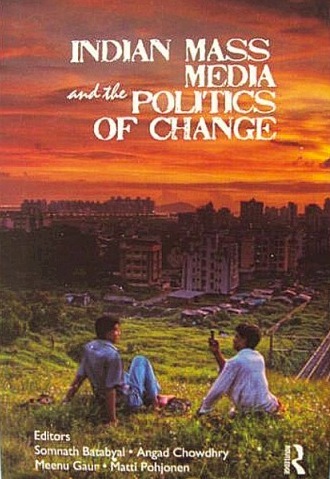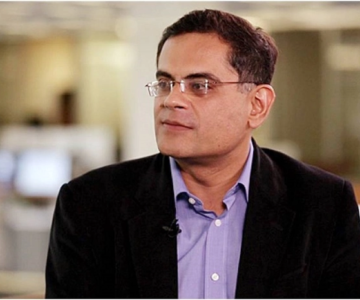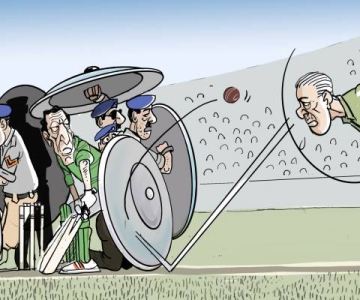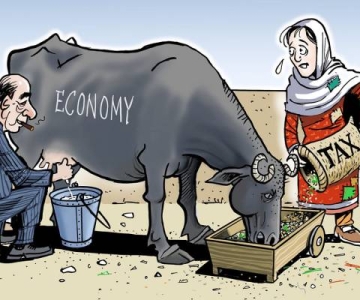Four comrades at the School of Oriental and African Sciences (SOAS) conceived this book around a collective they called Sacred Media Cow to make sense of the rising Indian mass media and its ubiquitous nature, its articulation of a middle class vision, and how through this process Indian nationalism was being redefined.
The four editors – Somnath Batabyal, Angad Chowdhry, Meenu Gaur and Matti Pohjoen — are also contributors to this volume; and have assembled an impressive array of essays which move from mass media, news channels, to mainstream and regional cinema arriving at the rise of digital cultures of India. Through the book, we view the reimagining of India as a ‘shining’ middle class dream using the popular media lens, which are both powerful and trans-national. That is why the last essay, a poignant piece by Naresh Fernandes, The Uncomfortable Truth behind the Corporate Media’s Imagination of India closes in the various debates.
Fernandes makes an unpopular (and increasingly ‘unpatriotic’) conclusion: that despite the shining India narratives, India remains a poor, developing country with myriad problems. Using the stories of a reputed journalist P Sainath, this essay looks at the ‘other’ India which the ‘hyperreal’ media has rendered invisible to provide a more palatable vision for its key corporate target the middle classes. The conclusion of the essay is haunting as it cites the infamous TV commercial where the legendary actor Amitabh Bachchan indirectly blames the poor for ‘preventing India from realizing its true potential’. Pohjonen’s introduction also cites this memorable line from Sainath: “Evading reality helps no one…a society that does not know itself cannot cope.”
In the very first essay of the volume by John Hutnyk, entitled NDTV 24 X 7, the Hanging Channel: News Media or Horror Show?, the author employs an inventive approach to address the ailments of TV content. Using cultural studies, mythology, anthropology and several other theoretical tools, Hutnyk raises vital issues and questions. Most significantly, he highlights how nationalism and warfare in the local-global frame appear and reappear in the media cacophony. The following lines were most amusing to read (I couldn’t help notice how as relevant they sounded for Pakistani TV shows):
The 24X7 talk show is the bureaucratic form of parliamentary fiasco which provides the unedifying spectacle of a bland and phantasmatic version of politics alongside an entertainment-containment of debate: A Big fight.”
The author uses Afzal Guru (the man waiting to be hanged despite the admission of the Supreme Court that the evidence was not sufficient but they had to respond to popular clamour for ‘justice’) and the Mumbai 2008 attacks as two cases where the age of Kali Yuga (the final stage of spiritual deterioration in Hindu time cycle) are manifested. Note this passage on a show with Muslim experts:
“The compere chairs a passionate, wide ranging debate that only sometimes steers beyond..the protocols of expectation: speakers question the requirement for all Muslims to show remorse that the attackers were Muslims; the requirement of Muslims in India to show a distance to Pakistan; routine denunciations of Pakistan; praise for police and terror forces; concerns about lapses in security (solution “better funding of security forces and more training); calls for the guests to think of ways we can channel our anger and be ‘united as a nation’; and so on.”
Batabyal’s essay, Where Art Thou? News Practices in Indian Television, is brutal even though it carries a neutral, inquiring tone. The article shows how the lines between editorial and corporate in the news media are beyond blurred. His key conclusions are that editorial space is “prey to corporate policy”; and the content for almost all TV channels remains “largely unvaried”. To ‘sell’ news to the intended consumer, journalists from ‘privileged’ background are hired and the interaction leads to a “hegemonic articulation” of a “privileged nationhood”. Through his ethnographic work, the author narrates the internal struggles within the news channels to own, construct and interpret news as purely corporate exercises.
This essay rather engagingly details what happens within the mainstream sensationalist TV channels. As Batabyal notes, citing another study, such debates are not new. In the US, TV industry has been blamed for having “contributed to a decrease in the attention span and death of curiosity, optimism, civility, compassion for others, and abstract and conceptual reasoning.” Judging by the way young Pakistanis, fed on the last decade’s TV revolution, behave on TV and social media, these words are almost prophetic.
The third essay and most original in its perspective, is by Meenu Gaur where she looks at the popular cinema. In this robust article, ‘The Roja Debate and the Limits of Secular Nationalism’, Gaur explores the larger context of Hindi films as they construct national identities. Her command over the cinematic medium is impressive and authoritative as she invokes references to almost all the major films on the subject of Kashmir and its location within the Indian national project.
The problematic discourse of secular nationalism articulated by cinema is analysed in detail. In the earlier part of her essay, she succinctly defines the problem: “Given that Indian secularism is defined by the event of the Partition”, it would be correct to say that Indian secularism is defined against the “Muslim separatist” demand (for Pakistan). Secular nationalism in India gives the Muslim the choice, to “dissolve itself within the nationalist mainstream, and simultaneously give up any claim to being ‘representative’. Or be by definition (and perversely) ‘communalist’…”
Using the case of a ‘blockbuster’ film Roja, Gaur focuses on the exclusion and stereotyping of the Muslim minority in the identity formation of “secular India”. Gaur’s incisive commentary comes as a major feat of this volume. She is unsparing and honest: “The critics fail to acknowledge what Roja amply reveals…the inherent limits of Indian secularism itself.” Citing another study of the film, she quotes FF Devji: “…the Muslim would exist as a sign of national failure and remain a focus of attack even if there were no Hindu nationalist parties, because the real problem is not religiosity but the politics of [secular] nationalism itself.”
Another article of this volume, Identities in Ferment: Reflections on the Predicament of Bhojpuri Cinema, Music and Language in Bihar, co-authored by Ratnakar Tripathy and Jitendra Verma, looks at the evolution of micro-narratives such as that of Bhojpuri (spoken in Bihar and parts of Uttarpardesh) its contribution to the formation of a ‘Bihari’ identity. The middle class media worldview excludes these marginal processes and thus increases the disconnect between the constructed, partial view of Indian nationhood and its peripheral folk counterparts which the middle class India views with disdain.
Angad Chowdhry in MMS Scandals and Challenges to the Authority of News Mediation delves into the digital age and its discontents by looking at the increased tendency of the younger people to employ cell phone cameras as expressions of sexuality by recording sex videos and spreading them via Multimedia Messaging Service (MMS) and the internet. The ’empty’ signifiers change especially the hysteria related to MMS scandals is viewed in the context of how ‘change’ is being imagined in contemporary India alongside the amplification of fears of moral corruption etc.
Kriti Kapila’s crisp critique, Circulating Intimacies: Sex-Surveys, Marriage and Other Facts of Life in Urban India, looks at how urban sexuality and its construction ignores the pre-existing reality. The ‘new’ middle class sexuality also links up to the evolving imagination of Indian nationalism and how mass media is catalyzing it.
The book’s overlapping themes and sometimes contradictory perspectives, relate to the gigantic challenge of its key theme: exploring the complex relationships between shifting politics of ‘change’ and a mass (corporate) media. It succeeds due to its lively essays, the use of varied analytical approaches and the sheer candour with which it problematises mass media. Given the nascent stage of this media ‘revolution’ it sets a useful direction for debates within India and South Asia especially Pakistan where issues of marginality, nationalism, warfare and corporatization are equally paramount and perhaps intractable too.
This review first appeared in The Friday Times and later at Kafila.org



